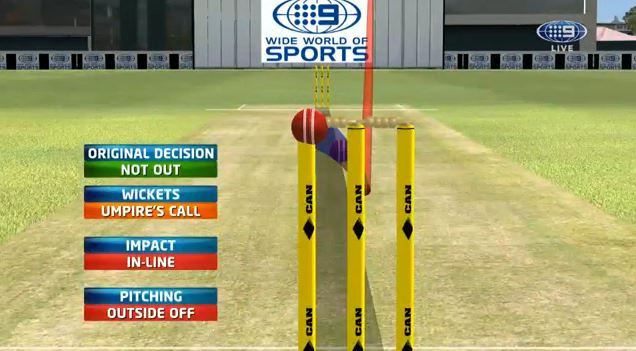@War I remember during the 2011 World Cup, it was India vs Ireland, and the Batsman in question Alex Cusack. Back then Umpire's Call also returned, if the batsman was 2.5 meters from the stumps.
Anyway, India appealed for LBW, and the on field Umpire ruled it n.o., India reviewed.
Now the ball was shown to be hitting the stumps, but at the same time since the batsman had stepped out, he was more than 2.5 mtrs from the crease.
Now because the batsman was 2.5 meters from the crease, because of 2.5 mtr rule Umpire's Call was the decision.
Now normally that would mean the original n.o. decision stood. However I think Rob Tucker who was the Umpire who ruled it not out originally, also saw the review on one of the big screens.
Now even though the batsman was 2.5 meters down, and Rob Tucker could have just let it go as N.o, as all Umpires do these days, upon seeing the replay, Rob Tucker himself overturned his own decision and changed it to OUT.
It was just brilliant, and made a lot of sense to me. I can't find the video, but here is cricinfo live commentary on it at the time -
92.1 kph, India have called for a lbw review here. Has Yuvi bagged a five-for? Lands back of a length on off stump and straightens, but the batsman is well down the track, his backfoot is a foot outside the crease and his front foot is well down the track. Will the 2.5 metres come into the picture? According to (a potentially inaccurate) HawkEye, since he is more than 2.5 m forward, it was hitting off and middle at a comfortable height. Right, on replays, umpire Tucker has reversed his decision and Yuvraj has five. Bangalore roars. Yuvraj puts out his hand, with all five fingers spread out. Dhoni just smiles. Good stuff this.
Now of course the 2.5 meter rule is no longer, but the principle behind it remains the same. If the Umpire upon a N.O LBW review sees that the ball he thought would miss the stumps, would partially clip the stump, and DRS says Umpire's Call, then upon seeing the replay, the Umpire over-rules himself, and rules it out. He thought the ball would miss the stumps, but when there is clear evidence that the ball would not miss the stumps, but hit the stumps, then he voluntarily overturns the decision.
If this type of pro-active umpiring becomes the norm, it would solve a lot of DRS ambiguities on its own.
Which brings me back to the main issue I have always had with DRS, and that is why not let the on field umpires voluntarily consult DRS, or atleast talk to the Third Umpire during review, to explain their basis for making whatever decision they did.



